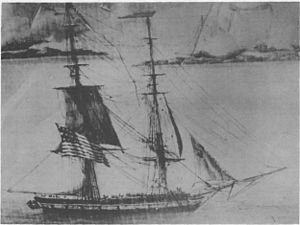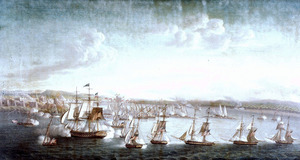USS Vixen (1803) facts for kids

Artist's drawing of Vixen as a brig
|
|
Quick facts for kids History |
|
|---|---|
| Name | USS Vixen |
| Ordered | 28 February 1803 |
| Builder | William Price |
| Cost | $20,872 |
| Laid down | 1803 |
| Launched | 25 June 1803 |
| Commissioned | 3 August 1803 |
| Fate | Captured by the British, 22 November 1812, and wrecked 27 November |
| General characteristics | |
| Type | Schooner |
| Displacement | 170 long tons (170 t) |
| Length | 83 ft 6 in (25.45 m) |
| Beam | 23 ft 2 in (7.06 m) |
| Depth of hold | 9 ft 6 in (2.90 m) |
| Propulsion | Sail |
| Complement | 111 officers and enlisted |
| Armament |
|
The USS Vixen was a fast sailing ship called a schooner that served in the United States Navy. She was one of four ships ordered by the United States Congress in 1803. Vixen was built in Baltimore, Maryland, and launched on June 25, 1803. Her first commander was Lieutenant John Smith.
Vixen at Sea
First Barbary War (1801–1805)
Vixen was built to sail in the shallow waters near Tripoli. She joined Commodore Edward Preble's group of ships for the First Barbary War. This war was fought against pirates from North Africa. Vixen left Baltimore on August 3, 1803. She arrived near Gibraltar on September 14.
In October, Vixen and the ship Philadelphia were sent to block the port of Tripoli. However, Vixen left to look for enemy ships. Because of this, she was not there when Philadelphia got stuck and was captured on September 30. Vixen then carried the news of Philadelphia's capture back to Gibraltar. This news included that Captain William Bainbridge and his crew were now prisoners.

The Americans quickly responded to the capture of Philadelphia. On February 16, 1804, Lieutenant Stephen Decatur, Jr. led a daring mission. He boarded and destroyed Philadelphia in Tripoli harbor. Later, Commodore Preble attacked Tripoli five times with heavy bombardments. These attacks happened in August and September 1804.
Vixen took part in all these battles. She helped coordinate the movements of the American ships. In October 1804, while in Malta, Vixen was changed into a brig. This was done to make her sail better. She continued to serve with the squadron, now led by Commodore John Rodgers. They were involved in actions near Tunis in August 1805. Vixen returned to the United States in August 1806.
Between Wars
After the war, Vixen was stored at the Washington Navy Yard. A year later, she began patrolling the Atlantic coast. She served under Lieutenants James Lawrence and Charles Ludlow.
In 1810, Vixen met a British ship, HMS Moselle, near Barbados. The British ship fired at Vixen. The British commander apologized, saying he couldn't see Vixen's flag clearly. He thought she might be a French pirate ship he was looking for. One American sailor was hurt in the incident.
War of 1812
Vixen kept patrolling the Atlantic coast until the War of 1812 began. She sailed along the southern coast. Her commander was Master Commandant Christopher Gadsden, Jr.. After his death in August 1812, Lieutenant George Washington Reed took command.
During a patrol in the West Indies, Vixen met a British frigate, Southampton. This British ship was much larger and more powerful. Southampton chased Vixen and captured her on November 22, 1812.
The British captain described Vixen as a brig with twelve 18-pounder guns and two 9-pounder guns. She had a crew of 130 sailors. Vixen had been at sea for five weeks but had not captured any enemy ships.
What Happened to Vixen
Just five days after Vixen was captured, both Southampton and Vixen were wrecked. They ran aground on Conception Island in the Bahamas. Luckily, all the officers and crews from both ships survived. However, Lieutenant Reed, Vixen's last commander, later died from yellow fever in Jamaica.

